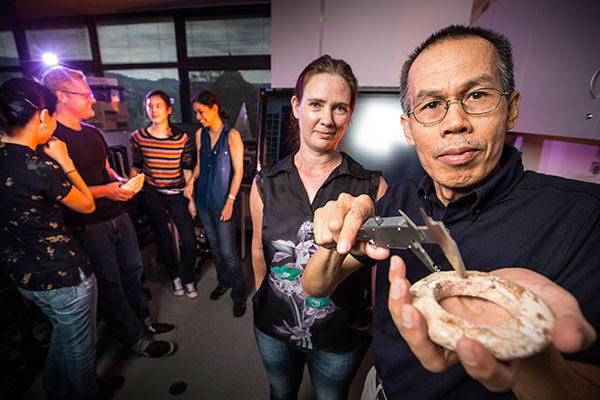March 20, 2015
Excavating ancient knowledge through archaeology partnership
Prehistoric shell artefacts excavated from ancient graves in Thailand have been under the microscope at UOW thorough a joint project with a renowned Thai archaeologist.

Professor Thanik Lertcharnrit, of Silpakorn University, has been a guest of UOW at the Centre for Archaeological Science’s Zooarchaeology Laboratory, which is one of the few labs worldwide that focuses on the detailed analysis of archaeological shell artefacts.
Professor Lertcharnrit and UOW’s Associate Professor Kat Szabó (pictured above) have been conducting analysis of the Iron Age artefacts that were recently excavated at a site called Phromthin Tai.
The excavation site focuses on a small ancient moated town in central Thailand that was though to have been first occupied during the late Bronze Age (circa 700 to 500 BCE).
The Iron Age layers contain the bulk of shell artefacts and are dated from approximately 500 BC to 500 AD.
Phromthin Tai received little attention and study until excavations in 1991. The secrets of history the unearthed at the site are vitally important in helping researchers build on the relatively poorly understood knowledge of the transition from the period of prehistory through to the emergence of early Thai kingdoms.
Research by Professor Lertcharnrit revealed the site is dominated Iron Age burials but also contains some evidence of copper smelting and ingot production, likely for trade and exchange with neighbouring communities.
Iron Age burials in Thailand were richer in grave goods and a number of the graves excavated at Phromthin Tai contained artefacts made from marine shell, especially bracelets and beads, while some skeletons still had bracelets around their arms and shell earrings recovered from either side of the skull.
“There has been little intensive focus on the study of shell artefacts within Thai archaeology, and methods for their detailed study are moving quickly worldwide,” Professor Szabó said.
A group of PhD students and undergraduates who work with Professor Szabó have joined her and Professor Lertcharnrit to assist in analysis and develop their analytical skills.
“We hope that the analysis of the Phromthin Tai shell artefacts will be a pilot that leads to a more expansive study of prehistoric Thai shell artefacts, which are many and varied,” she said.